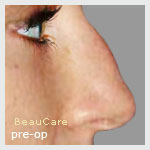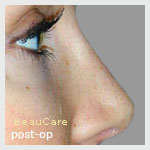Nose correction surgery or rhinoplasty, is an invasive form of cosmetic surgery because of the complexity of this organ. But it is one of the most common types of plastic surgery. The main indications for rhinoplasty are : hump on nose bridge, crooked nose, big nose, nose tip surgery. Surgery can be performed from the age of eighteen up until seniors.
In order to obtain the best results, careful analysis of the current shape is required. It is also important that the patient has realistic expectations.
This will be discussed with the surgeon during the consultation.
Prior to the surgery, you will receive all the necessary instructions. Such as when you are allowed to eat and drink before the operation and also with regards to taking medication.
Your surgeon will ask questions about your medical history and medical conditions. If you have caught a cold, the surgery has to be delayed.
Surgery will be performed under general anaesthesia and takes about one or two hours. You can leave the clinic the same day. However, it is necessary to arrange for someone to pick you up.
The Procedure
Your surgeon will make cuts between or inside your nostrils. The skin will be separated from the cartilage or bone and the reshaping can start.
There are two techniques for nose reshaping. The “closed technique” in which the operation is performed through the nostrils. The scars are in the nose, so there is no scar visible on the outside. And the “open technique” in which the incision is made in the skin underneath the nasal septum. The scar will be almost invisible.
After the surgery, a tampon will be put in the nose to minimize the risk of bleeding. A splint will be put over the nose to maintain the new shape of the nose. The tampon will be removed after one or two days. The splint is removed after about one week. Stitches, will be removed one to two weeks after the nose surgery. Sometimes absorbable stitches are used, meaning that the stitches will dissolve and do not have to be removed.
Possible risks
All surgeries carry some risks such as infection, bleeding or a bad reaction to anaesthesia. Before the surgery, your surgeon will inform you of the possible complications of rhinoplasty.
Medication containing aspirin or ibuprofen should be stopped two weeks before and after surgery. These medications slow down the blood-clotting process and may increase bleeding. Take only medication which have been approved by your surgeon (also herbal remedies and food supplements).
If you smoke, stop smoking before and after the surgery. Smoking slows the healing process after surgery and increases the risk of an infection.
Recovery and result
There will be bruising for a period of a week to ten days. Also discolouration of the eyelids and the cheeks might be expected for about one week. The tip of the nose can be sensitive and remain numb for months.
To reduce the swelling more quickly, it is recommended to sleep with some extra pillows or to lift the head of your bed.
A nose correction is generally not painful but might give you some discomfort. It is important to not sneeze or blow your nose the first two weeks after nose surgery. Strenuous activities, running and swimming are not allowed up to six weeks after your nose correction surgery.
You should avoid pulling clothing over your head for a few weeks.
Also sun exposure should be avoided because this could permanently discolor the skin around your nose.
Most patients can resume their normal daily activities one week after the surgery. The final result is seen after six to twelve months after all swelling has been resolved.
The BeauCare quality
Nose tip correction
Some persons might desire a correction of the nose tip. This can be discussed during a consultation with the plastic surgeon.
Nose: Prices in Euros
| Partial nose reshaping |
4950 - 5850 € VAT incl. |
| Nose reshaping / rhinoplasty |
5850 - 6950 € VAT incl. |




